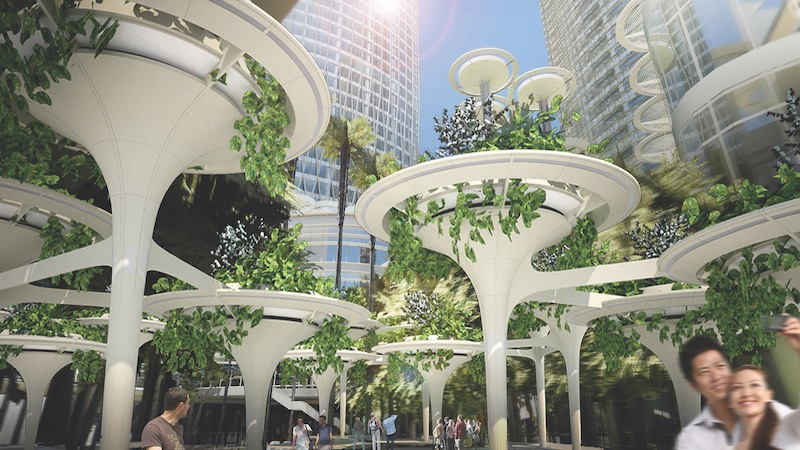Oscillating fans and sun umbrellas aren’t effective for cooling in hot and humid climates. Considering that, CallisonRTKL is developing Xylem, a self-sustained outdoor cooling system that can lower temperatures roughly 9°F when compared to shaded areas.
The martini-glass-shaped pods have a canopy with PV panels and a green roof, which blocks the sun and cools the air above through evaporation. The stem allows natural air movement and radiant cooling, as air emanates from both the insulated stem and the porous ceramic flooring.
The project’s genesis comes from “xylem,” the transport tissue in plants that moves water from roots to shoots and leaves. For the pods, cooled water circulates from the base through its structural core and conductive cladding.
“It works like a tree, but in many ways, it augments the qualities of a tree,” says Pablo La Roche, an Associate VP with CallisonRTKL and Xylem’s creator.
A single Xylem pod will provide comfort for individuals, but clustering them will be more effective. A strategy involving multiple Xylems and trees, green roofs, cool roofs, and cool pavements will reduce sun-exposed pavement and lessen the effects of a heat island.
“If we had many of these Xylems, combined with all sorts of different strategies, you can reduce the temperature of the air around the city by maybe 1.5°F to 2°F,” says La Roche.
The pods come in heights between 11 and 23 feet and are suited for markets, playgrounds, beaches, and other community spaces.
The first Xylem prototype will be tested at the end of August in Jakarta, Indonesia.
Read about more innovations from BD+C's 2016 Great Solutions Report
Related Stories
Design Innovation Report | Apr 27, 2023
BD+C's 2023 Design Innovation Report
Building Design+Construction’s Design Innovation Report presents projects, spaces, and initiatives—and the AEC professionals behind them—that push the boundaries of building design. This year, we feature four novel projects and one building science innovation.
Design Innovation Report | Apr 19, 2023
Reinforced concrete walls and fins stiffen and shade the National Bank of Kuwait skyscraper
When the National Bank of Kuwait first conceived its new headquarters more than a decade ago, it wanted to make a statement about passive design with a soaring tower that could withstand the extreme heat of Kuwait City, the country’s desert capital.
Design Innovation Report | Apr 19, 2023
HDR uses artificial intelligence tools to help design a vital health clinic in India
Architects from HDR worked pro bono with iKure, a technology-centric healthcare provider, to build a healthcare clinic in rural India.
3D Printing | Apr 11, 2023
University of Michigan’s DART Laboratory unveils Shell Wall—a concrete wall that’s lightweight and freeform 3D printed
The University of Michigan’s DART Laboratory has unveiled a new product called Shell Wall—which the organization describes as the first lightweight, freeform 3D printed and structurally reinforced concrete wall. The innovative product leverages DART Laboratory’s research and development on the use of 3D-printing technology to build structures that require less concrete.
Cladding and Facade Systems | Apr 5, 2023
Façade innovation: University of Stuttgart tests a ‘saturated building skin’ for lessening heat islands
HydroSKIN is a façade made with textiles that stores rainwater and uses it later to cool hot building exteriors. The façade innovation consists of an external, multilayered 3D textile that acts as a water collector and evaporator.
Transportation & Parking Facilities | Mar 23, 2023
Amsterdam debuts underwater bicycle parking facility that can accommodate over 4,000 bikes
In February, Amsterdam saw the opening of a new underwater bicycle parking facility. Located in the heart of the city—next to Amsterdam Central Station and under the river IJ (Amsterdam’s waterfront)—the facility, dubbed IJboulevard, has parking spots for over 4,000 bicycles, freeing up space on the street.
Concrete | Jan 24, 2023
Researchers investigate ancient Roman concrete to make durable, lower carbon mortar
Researchers have turned to an ancient Roman concrete recipe to develop more durable concrete that lasts for centuries and can potentially reduce the carbon impact of the built environment.
Sponsored | Resiliency | Dec 14, 2022
Flood protection: What building owners need to know to protect their properties
This course from Walter P Moore examines numerous flood protection approaches and building owner needs before delving into the flood protection process. Determining the flood resilience of a property can provide a good understanding of risk associated costs.
Giants 400 | Nov 14, 2022
4 emerging trends from BD+C's 2022 Giants 400 Report
Regenerative design, cognitive health, and jobsite robotics highlight the top trends from the 519 design and construction firms that participated in BD+C's 2022 Giants 400 Report.
AEC Tech | Apr 13, 2022
A robot automates elevator installation
Schindler—which manufactures and installs elevators, escalators, and moving walkways—has created a robot called R.I.S.E. (robotic installation system for elevators) to help install lifts in high-rise buildings.















